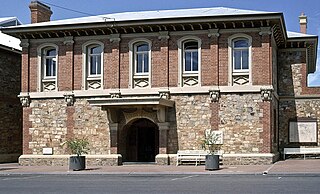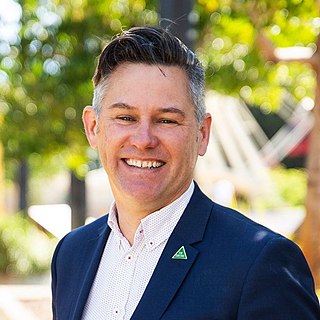
Fremantle is a port city in Western Australia, located at the mouth of the Swan River in the metropolitan area of Perth, the state capital. Fremantle Harbour serves as the port of Perth. The Western Australian vernacular diminutive for Fremantle is Freo.
The Fremantle line is a suburban railway and service in Western Australia that connects the central business district (CBD) of Perth with Fremantle.

Perth railway station is the largest station on the Transperth network, serving the central business district of Perth, Western Australia. It serves as an interchange between the Airport, Armadale, Fremantle, Joondalup, Mandurah, Midland, and Thornlie lines as well as Transwa's Australind service.

The Army Museum of Western Australia is a museum located in an historic artillery barracks on Burt Street in Fremantle, Western Australia. The museum was established in 1977 and has three Victoria Crosses on display.

East Fremantle is a suburb of Perth, Western Australia, located 13 kilometres (8.1 mi) south-west of the central business district. The suburb is mainly residential, and is coterminous with the Town of East Fremantle local government area.

The Town of Cottesloe is a local government area in the western suburbs of Perth, the capital of Western Australia. It covers the suburb of the same name as well as a tiny portion of the suburb of Claremont. Cottesloe is located 11 kilometres (7 mi) west of Perth's central business district, covers an area of 3.9 square kilometres (1.5 sq mi), maintains 45.7 km of roads and had a population of approximately 7,500 as at the 2016 Census. Cottesloe is served by Swanbourne, Victoria Street, Grant Street and Cottesloe train stations, all operated through the Fremantle Railway Line. Various bus routes operate along Stirling Highway, enabling transport through the suburb's western and eastern precincts with Perth and Fremantle. All services are operated by the Public Transport Authority. The Town of Cottesloe's inclusion of walk and cycle paths enable it to be a walkable precinct.

Cantonment Hill is a small rise overlooking the port city of Fremantle, Western Australia. Since the early 1900s the hill and the surrounding 4-hectare (9.9-acre) precinct has been mainly used for military purposes with extensive buildings now present. It has been under the control of the Department of Defence.

Walyalup Koort, formerly known as Kings Square (or King's Square), is a town square in Fremantle, Western Australia. It is bounded by Queen, Newman, William, and Adelaide Streets. Though the square was originally a public reserve, it has been the site of Saint John's Church of England since 1843, and the Fremantle Town Hall since 1887. High Street was extended through and beyond the square in the 1880s, but the portion through the square was closed off in the 1960s. Today Kings Square functions as a civic and cultural centre of Fremantle, with modern events taking place adjacent to the historic buildings.

Victoria Hall located on High Street, Fremantle designed by Talbot Hobbs was built between 1896 and 1897 as St John's Parish Hall, and renamed for the diamond jubilee of Queen Victoria in 1897. It was opened by Governor Smith and his wife on 28 September 1897.

Arthur Head in Fremantle, Western Australia, is a former large limestone headland on the southern side of the mouth of the Swan River, now also the entry to Fremantle Harbour.

The National Hotel is on the corner of High and Market Streets Fremantle. Originally built as a shop in 1868, it was occupied by the National Bank in the early 1880s. When the bank relocated in 1886, the building became the National Hotel.

Fremantle West End Heritage area is a designated heritage precinct in Fremantle, Western Australia.

The York Courthouse Complex, on Avon Terrace in York, Western Australia, was built from 1852 to 1896, and is one of the most significant built sites from a heritage and architectural perspective in the state.

Court Hotel or The Court is a music venue and bar in Perth, Western Australia.

Bradley William Pettitt is an Australian politician, who was Mayor of Fremantle in Western Australia from 2009 until 2021 and a Fremantle councillor from 2005 to 2009. At the 2021 state election, Pettitt was elected to the Western Australian Legislative Council as the sole member of the Greens Western Australia in the state upper house.

Swan Barracks was a military establishment in Francis Street, Perth, Western Australia. The heritage listed building is located between Museum and Beaufort Streets.
The Rock Machine–Rebels conflict is an ongoing conflict between the Rock Machine and Rebels motorcycle gangs in Perth, Western Australia. The conflict began in 2009 and has continued sporadically, with both clubs competing for territory and control of criminal rackets.
















